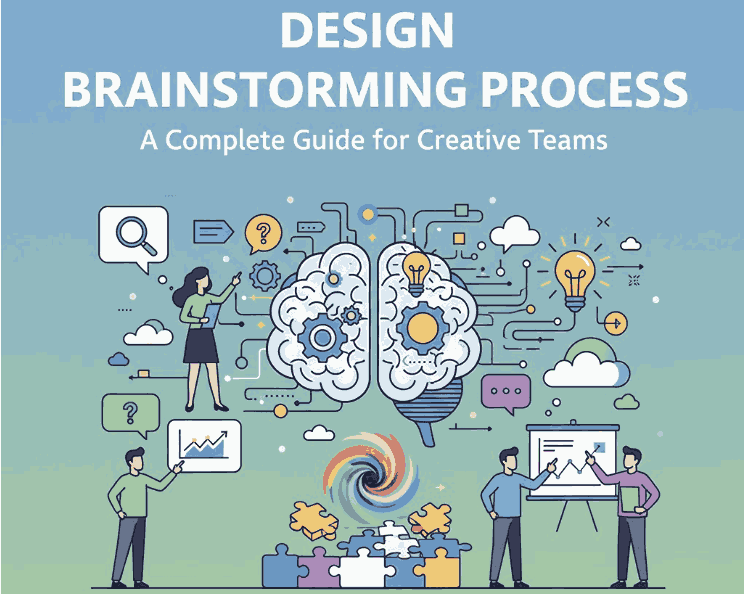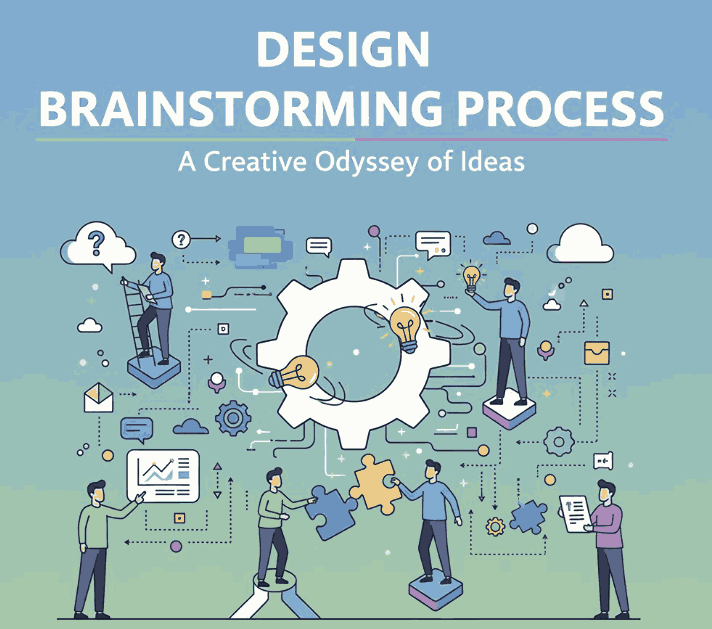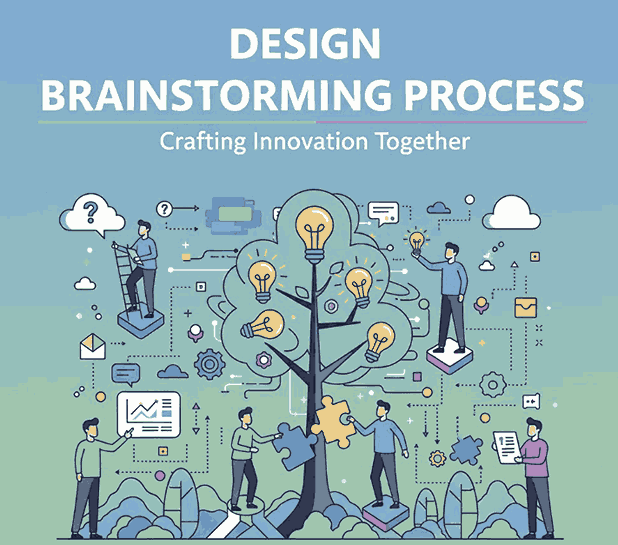
Table of Contents
- Introduction
- What Is the Design Brainstorming Process?
- Why Brainstorming Matters in Creative Projects
- Key Stages of the Design Brainstorming Process
- 4.1 Preparation
- 4.2 Idea Generation
- 4.3 Idea Evaluation
- 4.4 Refinement & Selection
- 4.5 Execution
- Best Techniques for Effective Design Brainstorming
- How Typography Supports the Brainstorming Workflow
- Recommended Fonts for Brainstorming Mockups
- Tips to Improve Your Brainstorming Sessions
- Conclusion
- References
1. Introduction
Design Brainstorming Process is an essential step in every creative workflow. Whether you are building a brand identity, designing a website, or crafting digital assets, brainstorming helps teams generate ideas, explore visual directions, and discover solutions that push creativity forward.
This article will guide you through the entire brainstorming process, explain why it is important, share effective brainstorming techniques, and show how typography plays a vital role—complete with recommended fonts from CalligraphyFonts.net.

2. What Is the Design Brainstorming Process?
The design brainstorming process is a structured method of generating, evaluating, and refining creative ideas for a design project. It allows designers, teams, or clients to explore concepts freely without judgment, encouraging innovation and unexpected creative outcomes.
Unlike ordinary idea collection, design brainstorming focuses on visual thinking, such as sketching, mood boards, typography experiments, mockups, color exploration, and rapid concept drafts.
3. Why Design Brainstorming Process Matters in Creative Projects
Brainstorming is not just a meeting—it is a strategic tool that improves your design work in several ways:
✔ Encourages Idea Diversity
A structured brainstorm allows participants to share ideas without limitation, resulting in wider creative options.
✔ Solves Problems Faster
Visual ideation helps reveal design issues early and speeds up creative decision-making.
✔ Boosts Creativity & Innovation
Brainstorming breaks mental blocks and encourages designers to think beyond predictable solutions.
✔ Strengthens Team Communication
Collaborative brainstorming aligns vision between designers, marketers, and clients.
✔ Leads to Stronger Visual Identity
Brainstorming helps designers unify typography, layout, color, and brand style in a purposeful way.
4. Key Stages of the Design Brainstorming Process
4.1 Preparation
This is where you define the project scope, design objectives, user needs, and brand direction. Designers gather:
- brand guidelines
- color palettes
- competitor analysis
- inspirational references
- target audience insights
4.2 Idea Generation
The fun part. Designers generate as many ideas as possible through:
- sketching
- freewriting
- mood boarding
- rapid prototyping
- typography exploration
- keyword mapping
No judgment—just creativity.
4.3 Idea Evaluation
Next, filter ideas to see which concepts align with project goals. Evaluate based on:
- brand consistency
- audience appeal
- visual clarity
- originality
- practicality
4.4 Refinement & Selection
Promising ideas are refined into clearer visual concepts. Designers improve:
- layout
- typography choices
- color combinations
- iconography
- illustration style
This stage transforms rough ideas into focused visual directions.
4.5 Execution
The final designs are created based on the refined concepts. This includes:
- high-fidelity mockups
- final typography
- color adjustments
- asset preparation
- client-ready presentations

5. Best Techniques for Effective Design Brainstorming Process
Use these proven techniques to elevate your brainstorming:
✔ Mind Mapping Design Brainstorming Process
Helps connect ideas visually and explore unexpected directions.
✔ SCAMPER Method Design Brainstorming Process
Substitute, Combine, Adapt, Modify, Put to another use, Eliminate, Reverse.
✔ Mood Boards Design Brainstorming Process
Great for exploring design style, aesthetics, fonts, and imagery.
✔ Sketch Storming Design Brainstorming Process
Rapid sketching pushes visual exploration early.
✔ Brain Writing Design Brainstorming Process
Team members write ideas silently—avoids group pressure.
✔ Typography Experimentation Design Brainstorming Process
Trying different typefaces quickly reveals brand personality.
6. How Typography Supports the Design Brainstorming Process Workflow
Typography is often a key element during the brainstorming stage. The right font can help define:
- tone and personality
- visual hierarchy
- emotional impact
- brand consistency
Using expressive styles—script, signature, brush, and calligraphy—can make brainstorming mockups feel more alive and inspiring. This is why designers often use premium display fonts early in ideation to visualize strong identity concepts.
7. Recommended Fonts for Design Brainstorming Process Mockups
Here are four font suggestions from CalligraphyFonts.net that work beautifully for design brainstorming presentations, mood boards, and mockups:
1. Rellative Font (Signature Style)
Elegant, modern, and expressive—perfect for branding and concept sketches.
2. Signatory Signature Font
A stylish handwritten font ideal for ideation notes, creative headers, and mood boards.
3. Holters Font
A bold, expressive brush font that brings energy to brainstorming visuals.
4. Anthonyela Calligraphy Font
A sophisticated calligraphy script that adds an artistic and premium feel to presentations.
Using these fonts in your brainstorming mockups instantly upgrades the look and communicates your design direction more effectively.
8. Tips to Improve Your Design Brainstorming Process Sessions
- Avoid judging ideas too early—creativity thrives on freedom.
- Set clear objectives so everyone understands the design goal.
- Use visual tools like sketches, fonts, and mood boards to unlock creativity.
- Limit sessions to 30–45 minutes to maintain energy and focus.
- Encourage wild ideas—they often lead to breakthrough concepts.
- Document everything to revisit sketches and notes later.
9. Conclusion Design Brainstorming Process
The design brainstorming process remains one of the most powerful tools for unlocking creativity and achieving innovative design solutions. Whether you’re working on branding, digital products, or print materials, brainstorming provides structure, clarity, and inspiration. Combined with strong typography choices—such as the fonts from CalligraphyFonts.net—your brainstorming workflow becomes more dynamic and visually engaging.
10. References
(Non-broken authoritative sources)
- DinStudio – What is Brainstorming? Do Designers Need It?
- Interaction Design Foundation – Ideation & Brainstorming
- AIGA – Creative Process Insights
